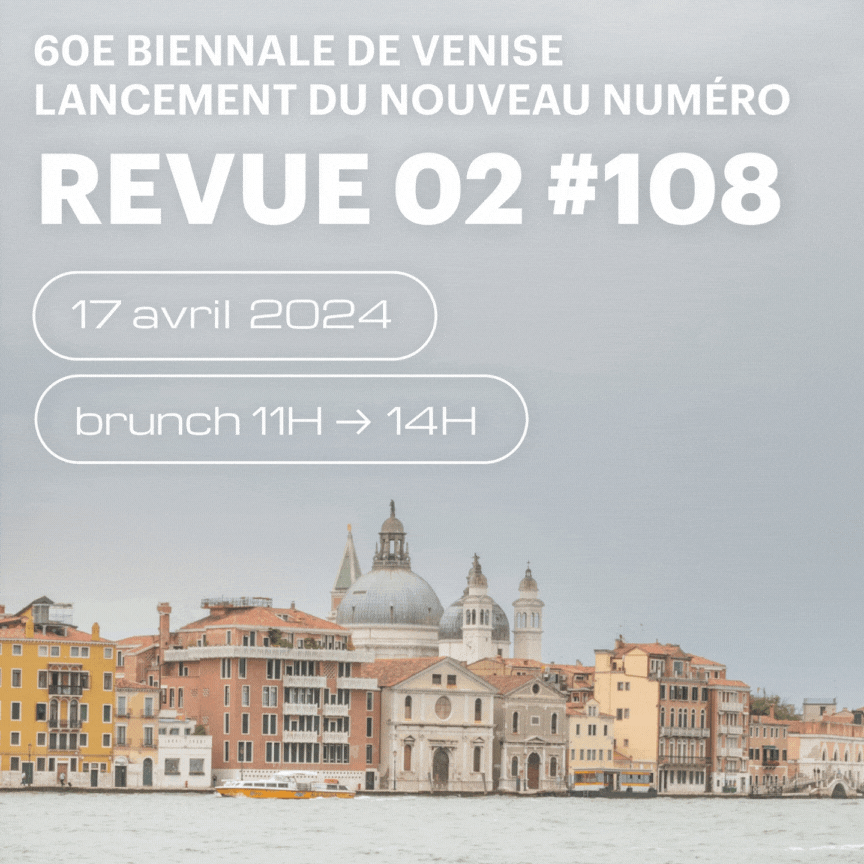Tobias Madison

Un son suivi des yeux
Tobias Madison a réalisé quatre vidéos entre 2012 et 2013, utilisant autant de techniques différentes et sur trois continents. Ces techniques permettent d’incarner, grâce à des systèmes rudimentaires d’intelligence artificielle, des liens invisibles entre l’homme, l’espace d’exposition et, par extension, la ville ; ces vidéos interrogent la façon dont ces technologies, reposant sur un regard qui n’est pas celui d’un être humain, connectent et pénètrent simultanément le corps, bouleversant son mode de perception de son entourage.
Tobias Madison et Jeanne Graff ont collaboré sur plusieurs projets depuis 2012. Ils sont membres du groupe Solar Lice.
Jeanne Graff : C’est à Hong Kong, en 2012, que tu as réalisé, avec Emanuel Rossetti, ton premier film avec un drone. MELT est composé d’un montage de plusieurs scènes très courtes filmées par le drone dans des lieux vides dans la ville.
Tobias Madison : Le projet a commencé par des questions sur le mouvement à proprement parler. Notre galerie, Karma International, nous avait proposé de faire un projet pour son stand sur la section Art Futures d’Art Hong Kong ; étant donné qu’un transport d’œuvres vers l’Asie coûte très cher, nous avons décidé de nous y « transporter » nous-mêmes et de faire une œuvre sur place. Nous avons passé trois semaines là-bas. La première semaine, n’avons rien fait mis à part déambuler dans la ville en observant l’architecture. L’espace urbain typique de Hong Kong est la zone commerciale, flanquée d’un système de surveillance très présent. Chaque espace de la ville a une valeur marchande. Nous avons commencé à travailler parallèlement sur deux pièces, la première est une série de boîtes en carton dans lesquelles nous avons construit des systèmes d’éclairage — l’idée nous en venue en observant des gens qui collectaient ces boîtes en carton pour les revendre tous les matins dans la rue pour gagner un peu d’argent. Nous avons commencé à faire la même chose, et avons donc réalisé cette série qui s’appelle No. Nous avons aussi acheté un drone, un jouet capable de filmer, et l’avons pris avec nous durant nos promenades en ville. Nous l’avons d’abord utilisé pour naviguer à travers la ville afin d’en avoir une perspective et des points de vue différents, jusqu’à que nous nous rendions compte qu’en fait, nous étions plus intéressés par le drone lui-même et par ses mouvements. Le drone se contrôle lui-même à travers un système primitif d’intelligence artificielle, deux caméras — une qui est attachée en bas, l’autre devant lui, de manière à ce qu’il ne heurte pas d’objet — et un gyroscope. Nous nous sommes vraiment intéressés à la manière dont ce système très primitif définissait les mouvements du drone, puis nous avons commencé à filmer uniquement en mettant le drone dans une certaine situation et en le laissant voler, ce qui donnait des images très minimales, à caractère inhumain. Nous avons aussi positionné le drone dans une situation où il faisait échouer son propre système, par exemple nous le faisions filmer des catelles dans une station de métro et il n’arrivait pas à enregistrer ces informations avec son sensor, les images filmées composaient une sorte de moirage ; cet effet optique était dû au fait que le drone ne pouvait plus mesurer les distances. Nous l’avons aussi placé devant un système de ventilation de manière à ce que ses mouvements réagissent au vent. Il est important de dire qu’aucune des images ne contiennent d’humains. Nous étions plus intéressés par des angles morts de la ville, des endroits ignorés, ce qui est très rare à Hong Kong. La lumière aussi dérangeait le drone, nous l’avons donc aussi fait filmer des éclairages publics.
As-tu également choisi ce type de caméra parce qu’elle interagit avec son environnement direct, ne différenciant pas les éléments humains de ceux non humains ? Les mouvements produits par le drone sont, de manière très visible, non humains.
T.M : Nous étions plus intéressés par le fait d’utiliser une caméra qui n’est pas maniée par un être humain, une caméra qui a son propre système, basé sur des calculs primitifs offrant une perspective non humaine sur une architecture complètement gouvernée et capitalisée par des êtres humains.
Pourquoi recherchiez-vous ce point de vue non humain ?
T.M : No, l’autre œuvre que nous avons réalisée à Hong Kong, était basée sur l’import-export. Hong Kong a l’un des ports les plus importants au monde, toutes ces boîtes en carton que nous avons utilisées étaient des colis d’exportation de fruits qui arrivaient de toutes sortes d’endroits. Nous sommes fascinés par les mouvements automatiques qui restent invisibles, la manière dont l’espace est contrôlé. C’est une approche très mathématique de l’urbanisme.
Nous avons souvent plaisanté sur l’idée du cyber-situationnisme qui serait une sorte de dérive automatisée dans la ville : tous les mouvements du drone sont simplement calculés à partir de n’importe quel fragment d’information qu’il comprend, il se déplace donc lentement et scanne l’architecture qui l’entoure.
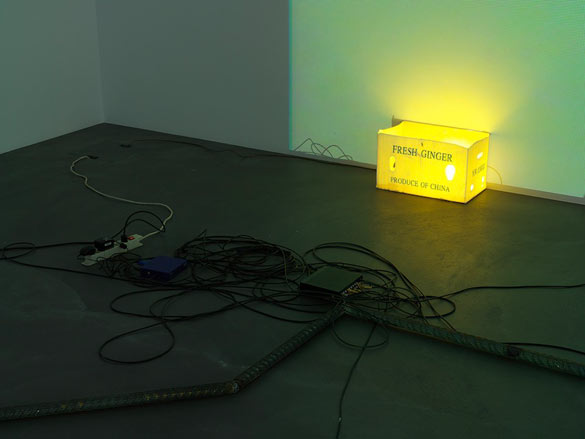
Tobias Madison, MELT (white/copper). Vidéo 11’ en boucle / Digital Video, 11’ looped. Vue d’exposition / Installation View : Tobias Madison, « NO; NO; H », Kunsthalle Zurich, 2013. Courtesy Tobias Madison
Les mouvements saccadés du drone, qui est en recherche permanente d’un point de vue, reflètent son environnement, ils sont aussi le reflet d’une technologie nouvelle et « mal maîtrisée », une technologie développée et utilisée par l’armée américaine comme instrument invasif de surveillance.
T.M : Le drone que nous avons utilisé était un jouet, ce qui le rendait plutôt sympathique, mais ce qui nous intéressait, c’était l’agressivité liée à cet objet, cette forme de menace immédiate qu’il produit. Nous avons essayé de le garder à un niveau qui est accessible à l’être humain tout en jouant avec ce mouvement qui n’est clairement pas celui d’un être humain… Nous cherchions à produire l’image d’une ville aseptisée menaçante qui, paradoxalement, véhicule une forme de glamour. C’est une ville extrêmement surveillée mais cet œil omniprésent n’est pas celui d’un être humain.
Avais-tu laissé le son du drone dans le film ? C’est un son très particulier, presque celui d’un insecte, rapide et incontrôlable. Je m’en souviens très bien dans le film réalisé par Ei Arakawa pour le Carnegie International en 2013, le drone était là comme un personnage, un fantôme, et il apparaissait aussi à l’image. [1]
T.M : Lorsque nous avons commencé à faire voler le drone, pour faire des tests, dans des zone de passage piétonnier, il avait un effet extrêmement menaçant et les gens faisaient de grands cercles autour de lui. Je pense que, contrairement à ce qui transparaît dans la vidéo d’Ei Arakawa, nous attachions peu d’importance à l’apparence du drone. Très intelligemment, Ei l’a utilisé comme une sorte de cinquième membre de la famille « patchwork » qu’il a composée et qui voyage dans son film, ce qui fait complètement sens dans sa pratique et que j’apprécie. Nous cherchions plus à mettre en avant cette sorte de menace inhumaine d’un personnage mathématique que l’humanisation de cette chose.
Tu as également écrit les sous-titres pour ce film.
T.M : Hong Kong vous envahit, c’est une ville très agressive, donc nous cherchions constamment des sorties. Nous passions la plupart de nos journées sur une plage de l’autre côté de l’île, à lire des livres de science-fiction et, la nuit, nous ramassions les cartons et nous filmions. Hong Kong véhicule une idée du futur tellement rétro… Les sous-titres étaient influencés par nos lectures de ces histoires de science-fiction : Maurice Dantec, William Gibson, John Varley… La plupart de ces textes évoquent une sorte de vie hors de la vie humaine. Nous avons essayé d’écrire un poème, le monologue d’un drone. Nous avons utilisé un programme de sous-titrage, il y avait des moments où le texte et l’image se chevauchaient, mais pas toujours : est-ce le drone qui parle ou quelqu’un au hasard dans la ville ? Cela crée des moments de distance qui suggèrent la présence d’un fantôme dans la machine.
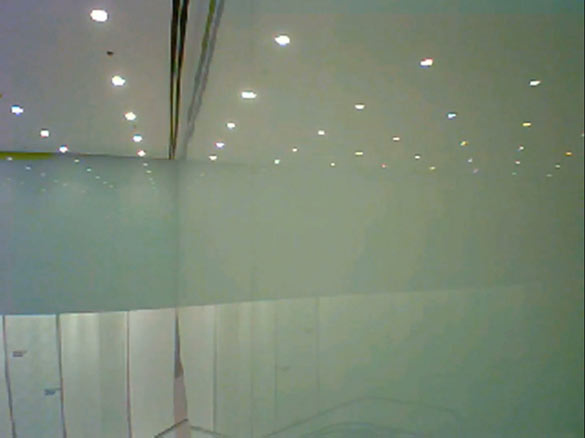
Tobias Madison & Emanuel Rossetti, MELT, 2012. Vidéo sous-titrée 11’ en boucle / Digital Video, Subtitle File, 11’ looped. Vue d’installation / Installation View : Art Hong Kong, Art Futures 2012. Courtesy Tobias Madison & Emanuel Rossetti
Quelques mois auparavant, tu avais réalisé un premier film, Feedback. Les mouvements de caméra y sont à l’opposé de ceux du drone : les caméras sont tenues par des personnes, mais le système de feedback instantané pourrait être vu comme une copie de celui du drone, au sens où il y a un calcul direct de l’environnement dans lequel la caméra se trouve.
T.M : Je venais d’ouvrir un cinéma indépendant à Zurich, AP News, et, au même moment, ma galerie m’a demandé de faire une exposition personnelle. J’ai considéré ce cinéma comme faisant partie de mon travail, et je me suis demandé comment « faire une exposition sans faire une exposition », je cherchais une manière de ne pas produire… J’ai commencé par combiner les idées de deux de mes amis : Emanuel Rossetti qui, pour son exposition à 1m3 à Lausanne, avait réalisé un système d’éclairage alternatif à celui de la galerie, et Kaspar Müller, qui a produit des stills d’après La nuit américaine de Truffaut avec une technique cinématographique qui consiste à mettre un filtre bleu devant la caméra pour simuler la nuit. J’ai donc développé un système d’éclairage bleu pour simuler la nuit et j’ai assemblé avec du scotch des restes de pièces que j’avais faites avant, puis j’ai fait ce système avec deux projecteurs vissés sur une caméra, qui projetaient simultanément ce que la caméra enregistrait pour créer une boucle de feedback de l’image dans cette lumière artificielle. J’ai invité mes amis à la galerie pour tester ce mécanisme et enregistrer une vidéo qui est, au final, essentiellement constituée des enregistrement de ces tests. La seule consigne était de ne pas trop parler, la vidéo enregistrait les mouvements des gens, leurs interactions, leur relation à l’architecture dépendant de ce système technologique construit sur place. On peut y voir des fragments de personnes, d’œuvres d’art et d’éclairage, des gens débattant en permanence pour savoir comment bouger à l’intérieur de ce système. En résultent ces mouvements très étranges et poétiques dans la galerie. C’était presque un pilotage automatique humanisé… Un système qui définit les mouvements mais sans instructions claires. On agissait de la même manière qu’un drone, réagissant aux gens, à l’architecture, au poids du projecteur qu’on avait dans nos mains, à l’éclairage, jusqu’à une sorte de navigation aveugle en cercle dans l’espace de la galerie.
Cette vidéo avait aussi du son, l’autre feedback parallèle à l’image était issu du feedback du microphone de la caméra qui donnait des informations approximatives sur la distance par rapport au projeteur par l’intensité du son. C’est le portait d’un groupe d’amis dans un certain contexte et qui représente ou incarne la technologie qui les lie.
Lors de ton exposition à la Kunsthalle de Zurich en 2013, tu as également utilisé le drone, cette fois comme mise en abîme de l’exposition, du white cube et, encore une fois, du vide, ce qui rend le discours sur le drone, ou la technique utilisée, encore plus visible.
T.M : Cette pièce (MELT white-copper, 2013) est essentiellement une fusion entre Feedback et la vidéo du drone de Hong Kong. Elle évoquait la place de l’institution comme celle d’un programme quasi-annexe d’un programme qui se déroulait à l’extérieur et qui consistait essentiellement en une série de soirées organisées dans un club, le Longstreet Bar, et de séances de projections et de conférences dans un cinéma, AP News. Je voulais créer un espace dans lequel le feedback était l’essence même du travail.
Les vidéos ont été tournées dans l’espace vide de la Kunsthalle juste avant mon exposition, tout le système d’éclairage était en fonctionnement, ce qui créait un espace incroyablement lumineux comme base d’enregistrement pour le drone. La luminosité était très déstabilisante pour le drone, ce qui avait pour résultat des mouvements très « drony » qui se projetaient à nouveau dans l’espace.
Les films réalisés dans l’espace d’exposition vide étaient ensuite projetés aux murs, ils fonctionnaient comme système d’éclairage et projetaient l’ombre des visiteurs sur ces murs.
T.M : Oui, il fallait marcher à travers les projections pour voir l’exposition, et cela créait ces silhouettes. Cela signifiait que l’on était en train de déranger un processus, plutôt que cela ne vous incluait dans l’image. Tous ces vieux projecteurs représentaient aussi une réflexion sur l’institution elle-même et son histoire, étant donné qu’ils ne lisent pas le signal vidéo analogue de la même manière, on avait des dégradés de vert et de bleu injectés dans le blanc, parfois aussi des coupes de noir hasardeuses.
Pour chaque projet, tu as utilisé ou inventé une technologie que tu ne maîtrisais pas vraiment, que tu utilisais souvent pour la première fois, dans une certaine immédiateté…
T.M : Je crois à la position d’amateur. J’ai commencé à m’intéresser à la technologie du drone quand j’ai commencé à en être un utilisateur, pas au moment où c’était une technologie militaire mais quand cela a commencé à devenir une technologie populaire, quand l’on pouvait dépenser deux cents francs pour en avoir un. Je m’intéresse à la relation qui s’établit entre la technologie et ses utilisateurs, et notamment leurs corps.
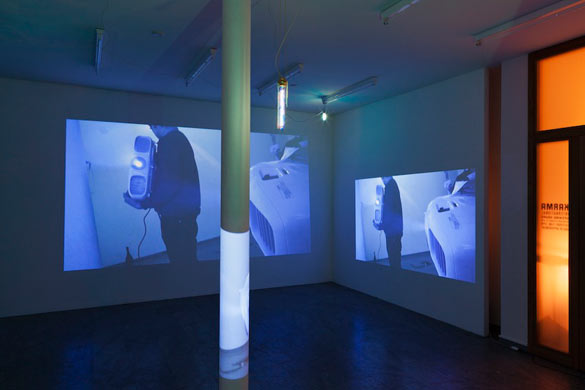
Tobias Madison, Feedback, 2012. Tissu, ampoules électriques, peinture thermo-résistante, vidéo 22’ en boucle / Fabric, lightbulbs, thermo-resistant paint, digital Video 22’ looped. Vue d’exposition / Installation View : Karma International, Zurich. Courtesy Tobias Madison
À Pittsburgh, tu as de nouveau réalisé un film, Workshop, avec des enfants de la ville. Les caméras étaient placées sur leurs têtes et ils dansaient dans le musée en se filmant, créant des mouvements très saccadés, qui paraissaient incontrôlés, rappelant ceux du drone.
T.M : J’ai utilisé une GoPro, une fois de plus un produit de consommation bon marché. Tout le projet a commencé avec un programme éducatif du musée. Le thème du Carnegie International était le jeu. Mon idée a été de donner accès au musée aux enfants, de manière à ce qu’ils puissent utiliser cet espace comme ils l’entendaient, en ayant un accès libre n’importe où dans le bâtiment. En même temps, je m’intéressais à la fétichisation de la culture expérimentale par le musée et les institutions et aussi à la manière dont on invente notre propre langage par rapport au monde qui nous entoure, ce qui est une activité quotidienne des enfants.
À nouveau, comme pour Feedback, j’ai utilisé ce système de caméra vissée à un projecteur mais, au lieu de celui que j’avais construit, j’ai utilisé ces caméras GoPro. J’ai équipé les enfants avec et nous avons commencé à faire des choses comme danser avec notre propre image, ou simplement déambuler dans le musée… Ils se sont aussi interviewés entre eux.
Ces quatre projets ont été réalisé très rapidement, entre janvier 2012 et 2013 et sont tous liés.
T.M : Ils avaient une certaine immédiateté, une touche « non finie », et s’attachent tous, de près ou de loin, au mouvement qui définit une institution, la dynamique sociale qui l’entoure et, par les mouvements de l’image, à sa relation à sa propre structure.
L’idée d’être relié par la technologie était vraiment évidente dans le film de Pittsburgh. J’observe également que tu passes d’un espace vide et déshumanisé à des scènes très denses avec tous ces enfants qui dansent.
T.M : Oui, mais elles parlent essentiellement de la même chose, de la manière dont la technologie pénètre notre corps et change notre perception de notre entourage, trouble les frontières. Tout arrive au même moment partout.
- ↑ Carnegie International est la plus ancienne et la plus importante grande exposition d’art contemporain des États-Unis, elle se déroule à Pittsburgh approximativement tous les trois ans. Sa dernière édition, du 5 octobre 2013 au 16 mars 2014, a été co-curatée par Daniel Baumann, Dan Byers et Tina Kukielski. L’artiste japonais Ei Arakawa y présentait un film réalisé avec Henning Bohl, Helena and Miwako, dans lequel un des personnage était un drone.
In conversation with Tobias Madison
A sound followed by the eyes
Tobias Madison made four videos in 2012 and 2013 on three continents, using a different technique for each. Thanks to rudimentary systems of artificial intelligence, these techniques allowed him to give form to the invisible links that exist between man, the exhibition space and, by extension, the city. The videos explore the way in which these technologies, which are based on a viewpoint that is not human, simultaneously connect and penetrate the body, thus disturbing its manner of perception and surroundings.
Tobias Madison and Jeanne Graff have worked together on several projects since 2012. They are both members of the group Solar Lice.
Jeanne Graff : It was in Hong Kong that, with Emanuel Rossetti in 2012, you made your first film using a drone. MELT is composed of a montage of very short scenes filmed by the drone in empty places in the city.
Tobias Madison : The project began with questions on movement, strictly speaking. Our gallery, Karma International, had asked us to do a project for its stand for the section Art Futures at Art Hong Kong. As it is very expensive to send works to Asia, we decided to “send” ourselves and to produce a work on the spot. We spent three weeks there. During the first week we did nothing but wander around the city looking at the architecture. Hong Kong’s most characteristic urban space is a commercial area flanked by a very present surveillance system. Each space in the city has a market value. We began to work on two pieces in parallel: the first is a series of cardboard boxes in which we built lighting systems – we got the idea when we were watching people collecting cardboard boxes that they resold each morning in the street to earn a little money. We began to do the same thing, and then we made this series we called No. We also bought a drone, a toy able to mount a camera, and took it with us when we went walking round the city. We first used it to navigate through the city so as to give us different perspectives and viewpoints, but then we realized that we were more interested in the drone itself than its movements. The drone controls itself using a simple artificial intelligence system. It has a gyroscope and two cameras – one is attached below, the other in front in a manner so it cannot bang against anything. We were very interested in the way that this very basic system controlled the drone’s movements, then we began to film simply by placing it in a certain situation and leaving it to fly. This gave very minimal, even inhuman, images. We put the drone in situations where its logic made its system fail, for example, we made it film tiles in a metro station but it couldn’t record the information with its sensor, thus the filmed images created a sort of watering effect. This was due to the fact that the drone couldn’t measure the distances involved. We also placed it in front of a ventilation system so that its movements reacted to the movement of the air. I should point out that none of the images includes people. We were more interested in the city’s blind spots, its non-places, which are very rare in Hong Kong. The light also upset the drone, so we also made it film the public lighting system.
Did you also choose this type of camera because it interacts with its immediate environment, not distinguishing between people and non-people? The drone’s movements are very clearly non-human.
T.M : We were more interested by using a camera that was not controlled by a person, a camera with its own system based on a simple logic that offered a non-human perspective on architecture completely governed and created by humans.
Why did you want this non-human perspective?
T.M : The other work we produced in Hong Kong, No, was based on import-export. Hong Kong has one of the world’s largest ports. All those cardboard boxes that we used had been used to transport fruit that arrived from all sorts of places. We were fascinated by the automatic movements that remain invisible, the way in which the space is controlled. It’s a very mathematical approach to urbanism.
We often made jokes about the notion of cyber-situationism, which would be a sort of automated dérive in the city: all the drone’s movements are simply calculated starting from any old piece of information that it understands. So it moves around slowly, scanning the surrounding architecture.
The drone’s jerky movements, while it constantly looks for a point of view, echo its environment. They are also a reflection of a new and “poorly mastered” technology, one developed and used by the US Army as an invasive surveillance tool.
T.M : The drone we used was a toy, which made it rather likeable, but what interested us was the aggressiveness linked with this object, the form of immediate threat that it produced. We tried to restrict it to a level that is accessible to a human being while playing with its movements, which are clearly not those of a human. We were trying to produce the image of a menacing and impersonal city that, paradoxically, communicates a sort of glamour. The city is subjected to a high level of surveillance but this omnipresent eye is not that of a human being.
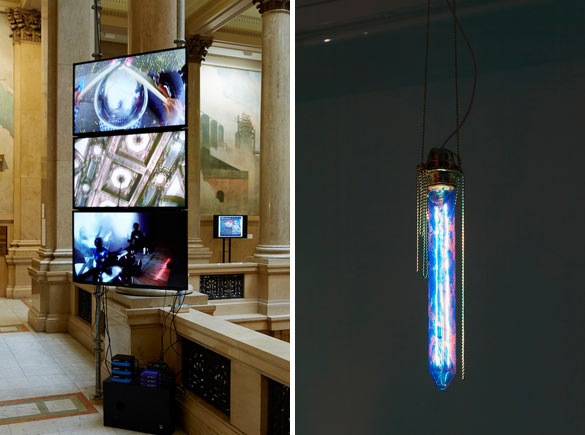
Tobias Madison, Workshop, 2013 (gauche/left). Vidéo tricanaux, 20’ au total, en boucle / Digital Video, 3-channel, 20min total, looped. Vue d’installation / Installation View: Carnegie International 2013, Carnegie Museum of Art, Pittsburgh. Courtesy Tobias Madison /// Tobias Madison, Feedback, 2012 (droite/right). Tissu, ampoules électriques, peinture thermo-résistante, vidéo 22’ en boucle / Fabric, lightbulbs, thermo-resistant paint, digital Video 22’ looped. Vue d’exposition / Installation View : Karma International, Zurich. Courtesy Tobias Madison
Did you leave the sound of the drone in the film? It is very particular, rapid and uncontrollable, almost like an insect. I have a clear memory that, in a film made by Ei Arakawa for the Carnegie International in 2013, the drone was like a character, a ghost, and it also appeared on screen. [1]
T.M : When we began to fly the drone, we tested it in a pedestrian precinct. It appeared very threatening and people circled widely around it. I think that, unlike what happened in Ei Arakawa’s video, we gave little importance to the drone’s appearance. Very intelligently, Ei used it as a sort of fifth member of the “patchwork” family that he created and travels in his film, and which makes complete sense in his practice – something that I like. We were trying more to put across the sense of a sort of inhuman menace of a mathematical character than to humanize the thing.
You also wrote the subtitles of the film.
T.M : Hong Kong takes you over. It is a very aggressive city so we were always on the lookout for excursions. We spent most of our days on the beach on the other side of the island reading science-fiction. At night we would collect cardboard boxes and film. Hong Kong is futuristic in such an old-fashioned way. The subtitles were influenced by the science-fiction we were reading: by Maurice Dantec, William Gibson, John Varley, etc. Most of them talk about life outside of human life. We tried to write a poem, the monologue of a drone. We used a subtitling program. There were moments when the text and the image overlapped, but not always. Is it the drone speaking or someone at random in the city? That produces moments when a little distance was created, which suggest the presence of a ghost in the machine.
A few months before, you made a film called Feedback. The camera movements are just the opposite of those of the drone: the cameras were held by people but the instantaneous feedback system might be considered a copy of that of the drone, in the sense that it’s based on a calculation of the environment the camera finds itself in.
T.M : I had just opened an independent cinema in Zurich – AP News – and, at the same time, my gallery asked me to do a solo exhibition. I considered this cinema as part of my work. I wondered how “to create an exhibition without creating an exhibition”, I was trying to find a way not to produce… I began to put the ideas of a couple of friends together: Emanuel Rossetti who, for his show at 1m3 in Lausanne, had made an alternative lighting system to the gallery’s, and Kaspar Müller, who produced stills in the style of Truffaut’s La nuit américaine using the movie technique of putting a blue filter over the lens to simulate night-time. So I developed a blue lighting system to simulate the night and stuck together with adhesive tape the rest of the pieces I had made before, then I created the system using two projectors screwed onto a camera, which simultaneously projected what the camera was recording so as to create a feedback loop of the image in this artificial light. I invited my friends to the gallery to test the mechanism and record a video; in the end, the video was essentially composed of the recording of these tests. The only instruction was not to talk too much; the video recorded the people’s movements, their interaction, and their relationship to the architecture dependent on this technological system built there on the spot. Bits of people can be seen, works of art and lighting, people endlessly discussing how to move within the system. The outcome is some very strange and poetic movements in the gallery. It was almost a humanized automatic piloting. A system that defined movements but without clear instructions. We were acting just like a drone, reacting to people, the architecture, the weight of the projector we were holding in our hands, the lighting, as though it was some kind of blind, circling navigation in the space of the gallery.
The video also had sound: the other feedback, in parallel to that of the image, came from the feedback of the camera microphone which gave rough information on the distance from the projector based on the intensity of the sound. It was a portrait of a group of friends in a certain context and which represents or embodies the technology they are linked by.
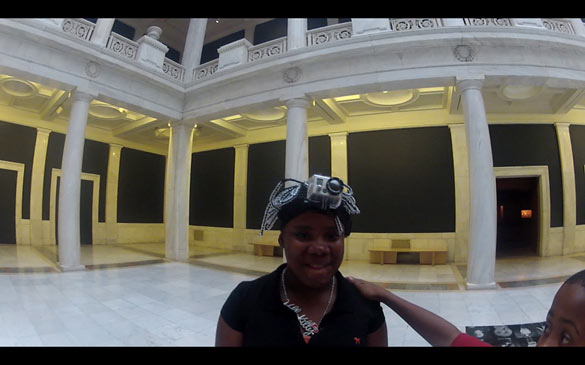
Tobias Madison, Workshop, 2013. Vidéo tricanaux, 20’ au total, en boucle / Digital Video, 3-channel, 20min total, looped. Vue d’installation / Installation View: Carnegie International 2013, Carnegie Museum of Art, Pittsburgh. Courtesy Tobias Madison
At your exhibition at the Kunsthalle in Zurich in 2013, you also used the drone. This time as a mise-en-abyme of the exhibition, the white cube and, again, of emptiness, something that brings the discourse on the drone, or the technique used, more into focus.
T.M : This piece (MELT white-copper, 2013) is essentially a fusion between Feedback and the drone video of Hong Kong. It referred to the Kunsthalle as a place where an almost subsidiary programme was taking place of a programme being held outside, which itself consisted essentially in a series of soirées organized in the Longstreet Bar, and of projections and lectures given in a cinema, AP News. I wanted to create a space in which the feedback was the essence itself of the work.
The videos were shot in the empty space of the Kunsthalle just before my exhibition. All the lighting system was working, which created an incredibly bright space for the drone to record. This brightness threw the machine into a bit of confusion, which resulted in rather “droney” movements that were projected once again in the space.
The films made in the empty exhibition space were later projected on the walls. They functioned like a lighting system and threw the shadows of the visitors onto the walls.
T.M : Yes, it was necessary to walk in front of the projectors to see the exhibition, ie. the silhouettes. What this meant was that we were disrupting a process, rather than the individual being included in the image. All these old projectors also represented a reflection on the Kunsthalle itself and its history, as they do not read the video signal in the same way, thus there were blended shades of green and blue in the white, sometimes in random sections of black.
For each project you used or invented a technology that you were not really in control of, which you were often using for the first time in a certain short-term context…
T.M : I believe in doing things as an amateur. I began to be interested in drone technology when I began to use it, not when it was a military technology but when it began to become used by the public, when it was possible to buy one for 200 francs. I am interested in the relationship between technology and its users, in particular their bodies.
You made another film, Workshop, in Pittsburgh with the city’s children. Cameras were placed on the kids’ heads and they danced in the museum as they filmed themselves. This created very jerky, seemingly uncontrolled movements, like those of the drone.
T.M : I used a GoPro, again a cheap consumer product. The whole project began with an educational programme for the museum. The theme of the Carnegie International was play. My idea was to open the museum up to the children so that they could use the space in the way they understood it, go wherever they wanted to in the building. At the same time, I was interested by the fetishisation of the experimental culture of the museum and other institutions, and also by the way we invent our own language in relation to the world around us, something that children do everyday.
Again, as for Feedback, I used this manner of attaching a camera to a projector but, instead of what I had built, I used these GoPro cameras. I fitted the kids out with them and we began to do things like dance with our own image, or simply walk around the museum. They also interviewed each other.
These four projects were made very quickly, between January 2012 and 2013 and there is a link between them all.
T.M : They shared a certain immediacy, an “unfinished” touch, and they are all linked, very closely or more loosely, to the movement that defines an institution, the social dynamic around it, and, through the movements of the image, to its relationship with its own structure.
The idea of being linked through technology was very evident in the Pittsburgh film. I also note that you pass from an empty space, without human presence, to very busy scenes with children dancing.
T.M : Yes, but they are essentially saying the same thing, referring to the way in which technology penetrates our body and changes our perception of what surrounds us: it blurs the boundaries. Everything arrives at the same moment everywhere.
- ↑ The Carnegie International is the oldest and largest exhibition of contemporary art in the United States. It is held in Pittsburgh approximately every three years. The last time it was held, 5 October 2013 to 16 March 2014, it was jointly curated by Daniel Baumann, Dan Byers and Tina Kukielski. The Japanese artist Ei Arakawa presented a film called Helena and Miwako, made with Henning Bohl, in which one of the characters was a drone.
articles liés
Anna Longo
par Clémence Agnez
Anne-Claire Duprat
par Vanessa Morisset
Entretien avec Katerina Gregos
par Anna Kerekes


